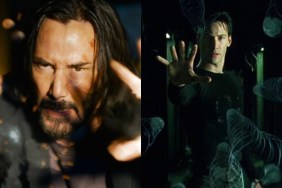I raved about John Wick in my Fantastic Fest review, and it blew away the festival audience too. Keanu Reeves stars as a retired hitman whose deceased wife leaves him a dog. When a Russian gangster kills that dog, Wick comes out of retirement for a personal vendetta, and the mob knows they’re in for it. John Wick is the directorial debut of second unit directors and action choreographers Dave Leitch and Chad Stahelski, who were in Austin to talk about the film. You can see John Wick when it opens October 24.
Related: The Best Movie Ever: Keanu Reeves
CraveOnline: Us fans tend to lament a movement toward the shakycam style of handheld camera and fast cutting, where you can’t really see the action. Has there been resistance to that on the second unit and choreography, since it obscures a lot of your work?
Dave Leitch: You can’t separate the choreography from the way you shoot it, so you approach everything as a whole package. There’s choreography, then you apply a camera method to accentuate it.
Chad Stahelski: Honestly, I think the problem is more with the choreographers and trainers. Like Dave said, if you start a movie as a choreographer, as a stunt coordinator or action designer and you know you’re not going to get any prep and you know you’re not going to get any time, and you’ve got a cast member that doesn’t have that physical level, and you still choreograph at this maximum Hong Kong level and expect to pull it off on the day, you’re delusional. This is without the director inputting his thing, but if you’re a good choreographer and you realize okay, this could be a rocky road, shakycam can lend itself. It adds frenetic energy. It helps hide things. It helps still give you that. But, on the other side of the coin, if you’re a good choreographer, if you’re a good action design guy, you have a great cast member, you have a production team, director, producer willing to do it, yes. Who doesn’t want to see cool action done by a cool guy? But we’re not dealing with Jackie Chan and Jet Li in every movie where you can let them do their thing. You’re dealing with the western version of things where you sometimes have to hide, help and accentuate.
That’s a very good point that the choreography has to go hand in hand with the style the director chooses.
Chad Stahelski: The style of director, the camera style and, let’s face it, the talent level of the cast. It’s a package. You can’t separate action design and choreography from shooting style and character. It’s all got to wrap into one. And then, like Dave’s saying, opportunity and solutions. Shakycam was a solution to some problems. How do we infuse more energy in a lackluster scene because we didn’t have the time to prep or the training? It works to a degree. We don’t shy against it, but as audience members ourselves, we prefer to see somebody good doing cool stuff for sure.
And you’re saying Keanu Reeves still retains that experience from the Matrix training and movies he’s done since?
Dave Leitch: Yeah, he’s one of those rare talents that can pull it off where you don’t have to use all your bag of tricks to make him look good. You can put the camera anywhere and the performance is going to deliver. He’s a physically gifted actor.
Chad Stahelski: We choreographed to what his strong points [are]. If you’re going to do a massive kicking sequence with flips and wirework, you can’t hold long takes. You have to cut for the wires, you have to cut for the impact, there’s reasons to cut. We tried to choreograph where we could let the action play out a little longer, five to 10 seconds sometimes, and let it exist. That’s why we went more with the grappling martial arts and some of the gun fu so we could actually sustain the shots, so you’d get involved and become invested in Keanu.

Had you saved any of your best moves for when you got your chance to direct to put them in John Wick?
Chad Stahelski: We saved some of our best theory. Maybe not best moves, but theory. Gun fu and some of that stuff, we saved.
Dave Leitch: I wouldn’t even say we saved it.
Chad Stahelski: We hadn’t had the opportunity to use it.
Dave Leitch: It’s just that you work on a second unit, you are a slave to the master director. You give him ideas but ultimately he’s going to choose and then you go on the path you design for him in collaboration with him.
Chad Stahelski: It’s funny, we pitched this to five other films and nobody wanted it.
Dave Leitch: And we’re like, “We love this stuff. We want this.”
Chad Stahelski: “Are you sure you guys don’t want it? We really like it.” But we’d pitch it and, “Nah, nah, it’s not this.” You’d laugh if we told you the reasons we got back from these other guys.
The reasons things don’t happen always astound me.
Chad Stahelski: It was pretty funny, so we’re like, “Wait a minute, is this bad? Everybody seems to be turning us down.” And we started to second guess. Then we’re like, “No, this is really cool stuff. Let’s use it in a movie.”
Dave Leitch: Why the body count is so high is that the choreography is immediate. In order to sustain a gun fu sequence, you need a lot of bodies, you need a lot of targets. A traditional fight scene is about a minute, 45 seconds so you start doing the math. It’s not like we wanted to kill 82 people. Well, maybe we did, but the choreography and the style we chose just lent itself to we need a lot of bodies to sustain a sequence, and it’s a cool dance so let’s go for it.
Chad Stahelski: We wanted the Fred Astaire version. We want the big one.
“It’s a taboo and don’t think that producers weren’t nervous about it.”
So the idea of combining gunplay and MMA fighting is something you’ve been pitching?
Chad Stahelski: It’s something we’ve always wanted to do and we’ve been pitching but again, it’s pretty reliant on style. Tonally, it’s more graphic novel and fun fantasy, modern day fantasy fun. You need a guy that will sit through it. Keanu went through weeks of tactical gun work with L.A. SWAT with some of our friends over in that world, as well as Japanese Jujitsu, Brazilian Jujitsu and Judo. That’s not an easy schedule to maintain for almost four months.
Audiences in general have an emotional reaction to animals on screen and have a knee jerk reaction if any animal is killed. Did you want to buck that “don’t kill the dog” trend?
Chad Stahelski: I don’t think we went that route. It was written that way. We thought it was a great motivation, it was something different and it lends itself to the graphic novel sensibility. This isn’t just killing his wife or beating somebody up. This is like he touched that sacred spot. If it was a real world movie like a Taken or something like that, I think that’s kind of edgy, but I think it lends to the gag that we’re in a hyperreal world and bad guys are bad.
And that every character agrees with the audience, like, “Oh, you did that? Well, John Wick is going to kill you and we’re going to let him.”
Dave Leitch: We can’t stop him. We’re going to let him and we can’t stop him. Yeah, it’s a taboo and don’t think that producers weren’t nervous about it.
Chad Stahelski: Very nervous.
Dave Leitch: Everyone was nervous about it and we felt really strongly that it was the right motivation for the tone of the piece that we were doing. We needed it to be different.
Chad Stahelski: Old Yeller. Jerks on the heartstrings. You can kill a lot of wives, but…
Dave Leitch: There’s nothing that resonates like that, and John Wick’s character is going to have to empathetically come back from a huge amount of carnage, so the hook has to be really, really strong or we’re going to lose the audience.
Chad Stahelski: It’s a fresh hook.

It is and it also does away with a lot of the clichés of the bad guy trying to buy off the hero. Even Viggo knows he can’t.
Chad Stahelski: And also, people look at the B-side of it. Yes, bad for the puppy and stuff, but the A-side of it is you have a guy that was endeared to it. It wasn’t so much that he lost that relationship as that he had it in the first place. How many vicious killers or how many hit man movies start off with somebody being that open? That’s a big deal for Keanu. To portray a tough guy or a hero that has to not only without a love interest per se, once his wife passes he falls in love with a puppy. That opens yourself up. He’s willing to go down that road of being endeared to a puppy. That shows a soft side that most hit men don’t portray.
You were very classy about it. Were you concerned about not overdoing the dog stuff?
Chad Stahelski: You didn’t want to make it sappy. It’s just what it is. I don’t think Keanu was any different than any one of us would be with a puppy.
Dave Leitch: Those moments are genuine reactions. You just put that dog in the room and your’e going to get a response. The best actor or the worst actor, you’re going to get a response from that dog.
Chad Stahelski: There’s a couple moments in there where that’s not John Wick. That’s Keanu Reeves with a puppy. Even he can’t deny. The dog doesn’t know it’s a movie. When it’s being cute, he’s just being a puppy. I think you can’t help but fall in love with that.
Dave Leitch: And I think in our minds, there was going to be a longer build to the relationship, like he’s not going to like it at first and then he’s going to like it and then he’s really going to have endeared himself to it. We almost threw out the progression. When the thing kisses him on the nose, that happened immediately.
Chad Stahelski: In editorial and even right after that sequence, we didn’t want to force it and pushing it more was forcing it. The dog became so endearing so quickly, I thought we had hit our mark. We didn’t want to push it, like you said.
Did this take you out of second unit for a while? Are you full time directors now?
Chad Stahelski: I’ll let you know October 25.
Fred Topel is a staff writer at CraveOnline and the man behind Best Episode Ever. Follow him on Twitter at @FredTopel.








